Research Methodology Report: Training and Development at Tesco
VerifiedAdded on 2023/01/06
|12
|2647
|75
Report
AI Summary
This report presents a research methodology proposal examining the impact of training and development on the performance of Tesco employees. The methodology section outlines the use of quantitative research methods, including the collection of numerical data through questionnaires. The sampling strategy involves a sample size of 80 Tesco employees, selected to gather insights into the company's training programs and their effects on employee performance. Data collection is conducted using a primary method, specifically questionnaires, designed to gather first-hand information on the subject. Ethical considerations, such as informed consent and data privacy, are addressed to ensure the integrity of the research. The expected outcomes include insights into the relationship between training and employee performance, the effectiveness of different training methods, and the identification of challenges. A timeline and Gantt chart are included to illustrate the project's schedule. The report concludes with references and an appendix containing the questionnaire used in the study.
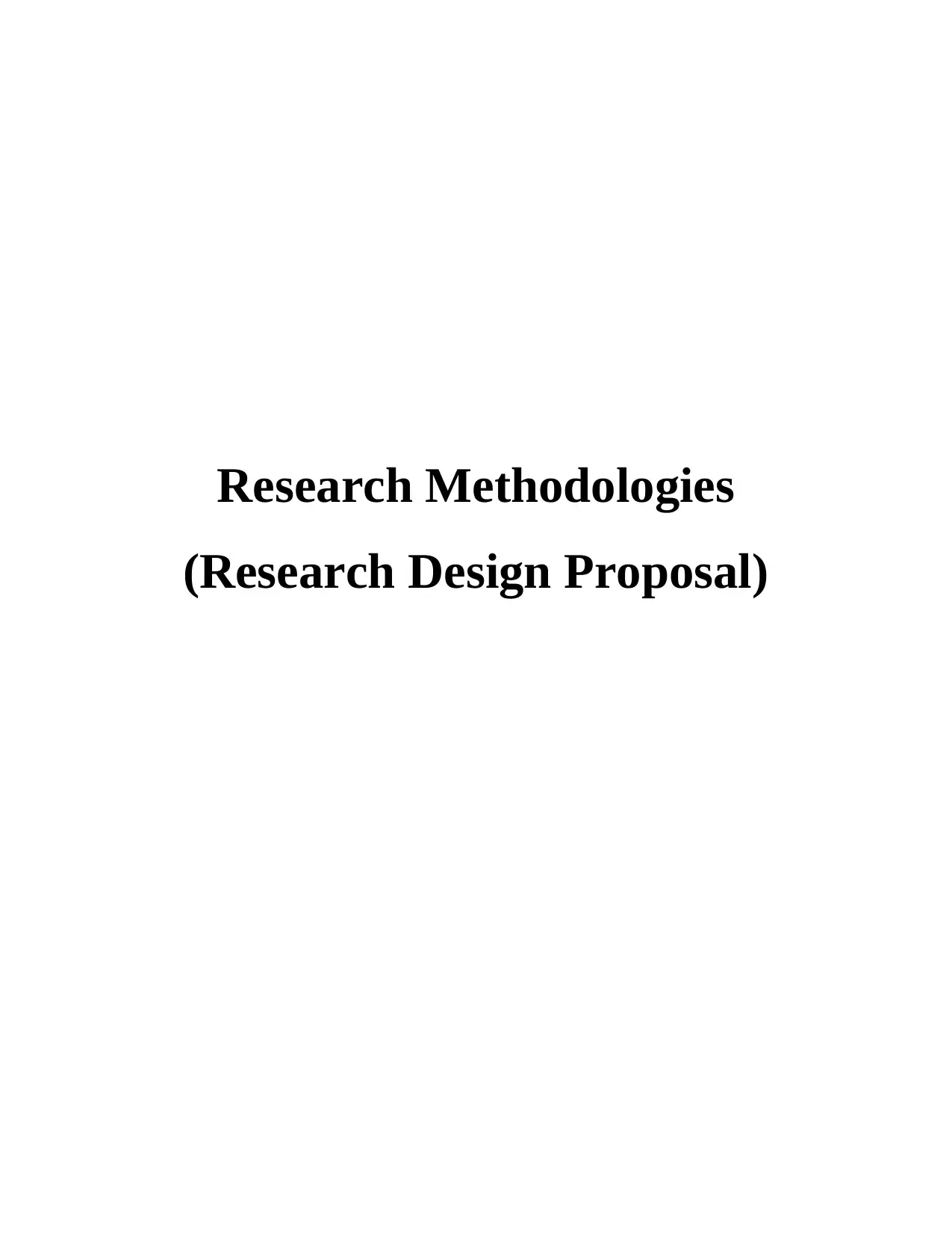
Research Methodologies
(Research Design Proposal)
(Research Design Proposal)
Paraphrase This Document
Need a fresh take? Get an instant paraphrase of this document with our AI Paraphraser
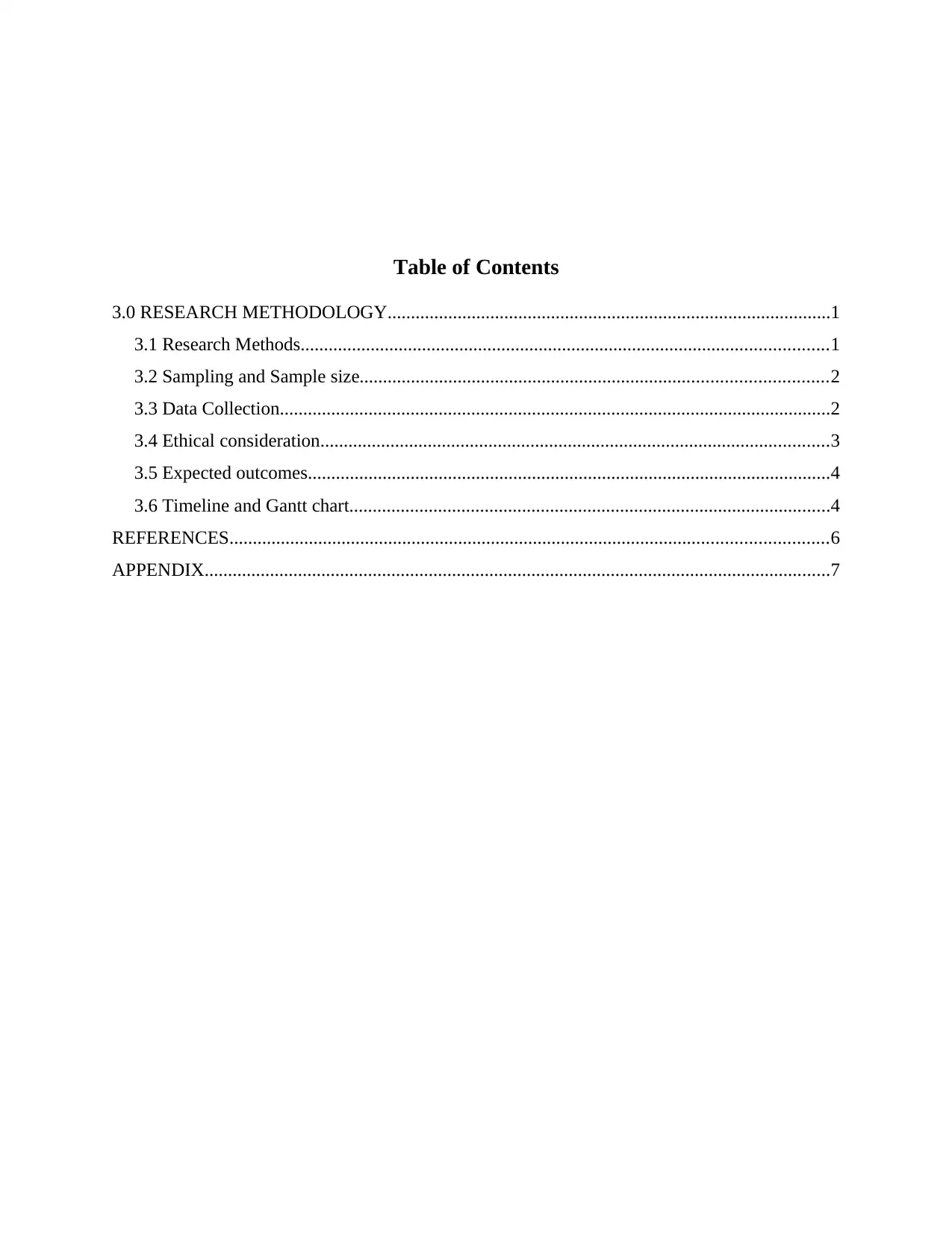
Table of Contents
3.0 RESEARCH METHODOLOGY...............................................................................................1
3.1 Research Methods.................................................................................................................1
3.2 Sampling and Sample size....................................................................................................2
3.3 Data Collection......................................................................................................................2
3.4 Ethical consideration.............................................................................................................3
3.5 Expected outcomes................................................................................................................4
3.6 Timeline and Gantt chart.......................................................................................................4
REFERENCES................................................................................................................................6
APPENDIX......................................................................................................................................7
3.0 RESEARCH METHODOLOGY...............................................................................................1
3.1 Research Methods.................................................................................................................1
3.2 Sampling and Sample size....................................................................................................2
3.3 Data Collection......................................................................................................................2
3.4 Ethical consideration.............................................................................................................3
3.5 Expected outcomes................................................................................................................4
3.6 Timeline and Gantt chart.......................................................................................................4
REFERENCES................................................................................................................................6
APPENDIX......................................................................................................................................7
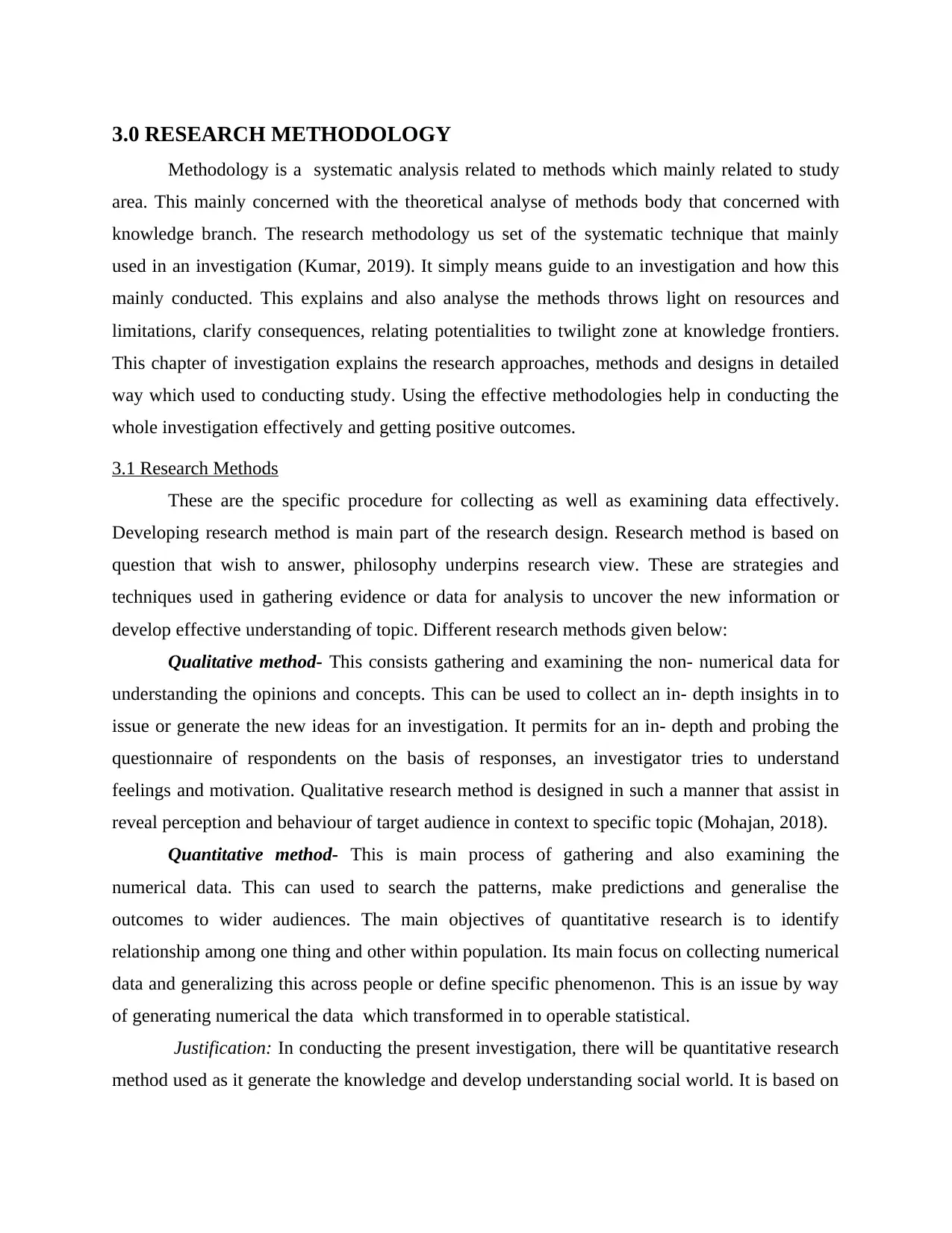
3.0 RESEARCH METHODOLOGY
Methodology is a systematic analysis related to methods which mainly related to study
area. This mainly concerned with the theoretical analyse of methods body that concerned with
knowledge branch. The research methodology us set of the systematic technique that mainly
used in an investigation (Kumar, 2019). It simply means guide to an investigation and how this
mainly conducted. This explains and also analyse the methods throws light on resources and
limitations, clarify consequences, relating potentialities to twilight zone at knowledge frontiers.
This chapter of investigation explains the research approaches, methods and designs in detailed
way which used to conducting study. Using the effective methodologies help in conducting the
whole investigation effectively and getting positive outcomes.
3.1 Research Methods
These are the specific procedure for collecting as well as examining data effectively.
Developing research method is main part of the research design. Research method is based on
question that wish to answer, philosophy underpins research view. These are strategies and
techniques used in gathering evidence or data for analysis to uncover the new information or
develop effective understanding of topic. Different research methods given below:
Qualitative method- This consists gathering and examining the non- numerical data for
understanding the opinions and concepts. This can be used to collect an in- depth insights in to
issue or generate the new ideas for an investigation. It permits for an in- depth and probing the
questionnaire of respondents on the basis of responses, an investigator tries to understand
feelings and motivation. Qualitative research method is designed in such a manner that assist in
reveal perception and behaviour of target audience in context to specific topic (Mohajan, 2018).
Quantitative method- This is main process of gathering and also examining the
numerical data. This can used to search the patterns, make predictions and generalise the
outcomes to wider audiences. The main objectives of quantitative research is to identify
relationship among one thing and other within population. Its main focus on collecting numerical
data and generalizing this across people or define specific phenomenon. This is an issue by way
of generating numerical the data which transformed in to operable statistical.
Justification: In conducting the present investigation, there will be quantitative research
method used as it generate the knowledge and develop understanding social world. It is based on
Methodology is a systematic analysis related to methods which mainly related to study
area. This mainly concerned with the theoretical analyse of methods body that concerned with
knowledge branch. The research methodology us set of the systematic technique that mainly
used in an investigation (Kumar, 2019). It simply means guide to an investigation and how this
mainly conducted. This explains and also analyse the methods throws light on resources and
limitations, clarify consequences, relating potentialities to twilight zone at knowledge frontiers.
This chapter of investigation explains the research approaches, methods and designs in detailed
way which used to conducting study. Using the effective methodologies help in conducting the
whole investigation effectively and getting positive outcomes.
3.1 Research Methods
These are the specific procedure for collecting as well as examining data effectively.
Developing research method is main part of the research design. Research method is based on
question that wish to answer, philosophy underpins research view. These are strategies and
techniques used in gathering evidence or data for analysis to uncover the new information or
develop effective understanding of topic. Different research methods given below:
Qualitative method- This consists gathering and examining the non- numerical data for
understanding the opinions and concepts. This can be used to collect an in- depth insights in to
issue or generate the new ideas for an investigation. It permits for an in- depth and probing the
questionnaire of respondents on the basis of responses, an investigator tries to understand
feelings and motivation. Qualitative research method is designed in such a manner that assist in
reveal perception and behaviour of target audience in context to specific topic (Mohajan, 2018).
Quantitative method- This is main process of gathering and also examining the
numerical data. This can used to search the patterns, make predictions and generalise the
outcomes to wider audiences. The main objectives of quantitative research is to identify
relationship among one thing and other within population. Its main focus on collecting numerical
data and generalizing this across people or define specific phenomenon. This is an issue by way
of generating numerical the data which transformed in to operable statistical.
Justification: In conducting the present investigation, there will be quantitative research
method used as it generate the knowledge and develop understanding social world. It is based on
⊘ This is a preview!⊘
Do you want full access?
Subscribe today to unlock all pages.

Trusted by 1+ million students worldwide
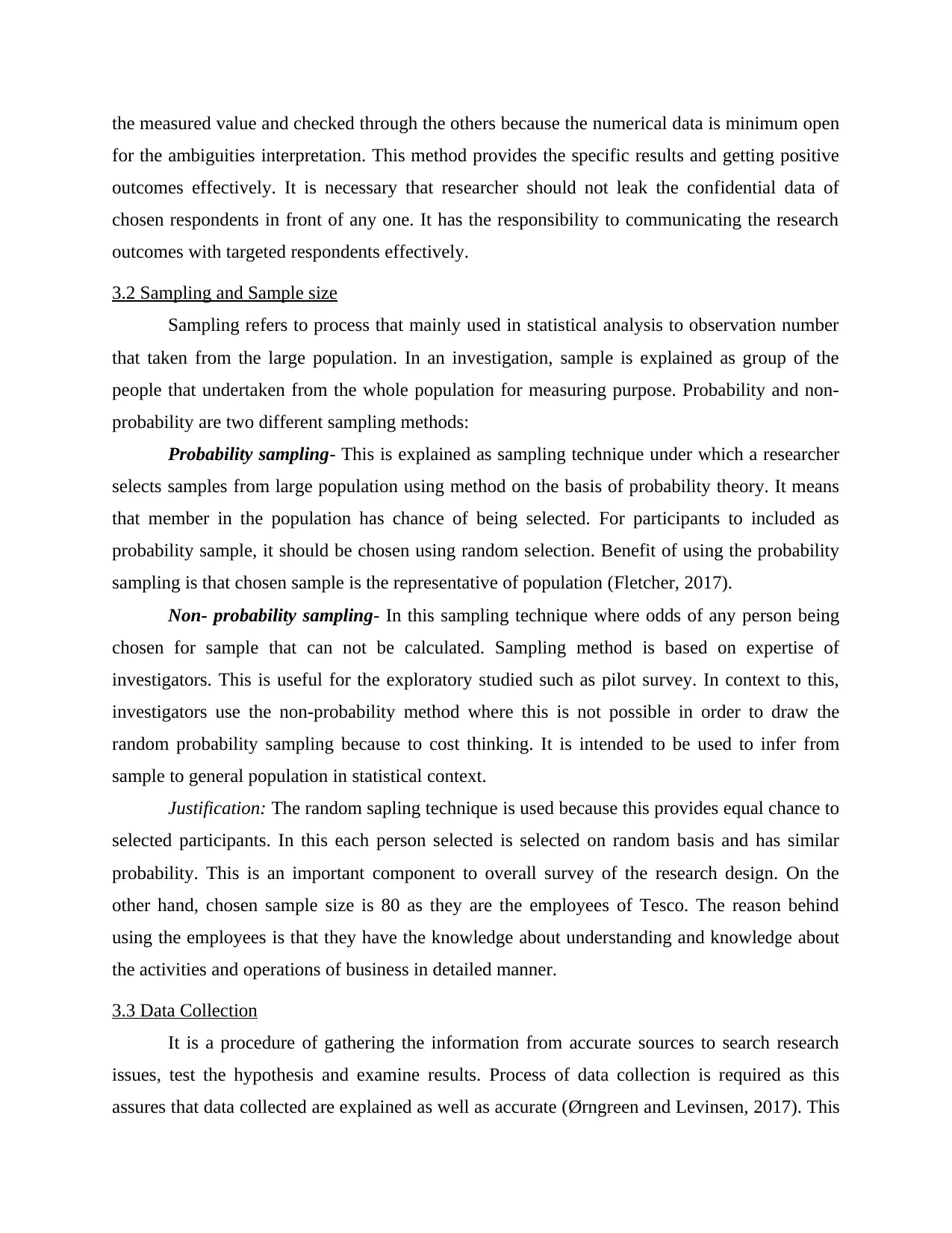
the measured value and checked through the others because the numerical data is minimum open
for the ambiguities interpretation. This method provides the specific results and getting positive
outcomes effectively. It is necessary that researcher should not leak the confidential data of
chosen respondents in front of any one. It has the responsibility to communicating the research
outcomes with targeted respondents effectively.
3.2 Sampling and Sample size
Sampling refers to process that mainly used in statistical analysis to observation number
that taken from the large population. In an investigation, sample is explained as group of the
people that undertaken from the whole population for measuring purpose. Probability and non-
probability are two different sampling methods:
Probability sampling- This is explained as sampling technique under which a researcher
selects samples from large population using method on the basis of probability theory. It means
that member in the population has chance of being selected. For participants to included as
probability sample, it should be chosen using random selection. Benefit of using the probability
sampling is that chosen sample is the representative of population (Fletcher, 2017).
Non- probability sampling- In this sampling technique where odds of any person being
chosen for sample that can not be calculated. Sampling method is based on expertise of
investigators. This is useful for the exploratory studied such as pilot survey. In context to this,
investigators use the non-probability method where this is not possible in order to draw the
random probability sampling because to cost thinking. It is intended to be used to infer from
sample to general population in statistical context.
Justification: The random sapling technique is used because this provides equal chance to
selected participants. In this each person selected is selected on random basis and has similar
probability. This is an important component to overall survey of the research design. On the
other hand, chosen sample size is 80 as they are the employees of Tesco. The reason behind
using the employees is that they have the knowledge about understanding and knowledge about
the activities and operations of business in detailed manner.
3.3 Data Collection
It is a procedure of gathering the information from accurate sources to search research
issues, test the hypothesis and examine results. Process of data collection is required as this
assures that data collected are explained as well as accurate (Ørngreen and Levinsen, 2017). This
for the ambiguities interpretation. This method provides the specific results and getting positive
outcomes effectively. It is necessary that researcher should not leak the confidential data of
chosen respondents in front of any one. It has the responsibility to communicating the research
outcomes with targeted respondents effectively.
3.2 Sampling and Sample size
Sampling refers to process that mainly used in statistical analysis to observation number
that taken from the large population. In an investigation, sample is explained as group of the
people that undertaken from the whole population for measuring purpose. Probability and non-
probability are two different sampling methods:
Probability sampling- This is explained as sampling technique under which a researcher
selects samples from large population using method on the basis of probability theory. It means
that member in the population has chance of being selected. For participants to included as
probability sample, it should be chosen using random selection. Benefit of using the probability
sampling is that chosen sample is the representative of population (Fletcher, 2017).
Non- probability sampling- In this sampling technique where odds of any person being
chosen for sample that can not be calculated. Sampling method is based on expertise of
investigators. This is useful for the exploratory studied such as pilot survey. In context to this,
investigators use the non-probability method where this is not possible in order to draw the
random probability sampling because to cost thinking. It is intended to be used to infer from
sample to general population in statistical context.
Justification: The random sapling technique is used because this provides equal chance to
selected participants. In this each person selected is selected on random basis and has similar
probability. This is an important component to overall survey of the research design. On the
other hand, chosen sample size is 80 as they are the employees of Tesco. The reason behind
using the employees is that they have the knowledge about understanding and knowledge about
the activities and operations of business in detailed manner.
3.3 Data Collection
It is a procedure of gathering the information from accurate sources to search research
issues, test the hypothesis and examine results. Process of data collection is required as this
assures that data collected are explained as well as accurate (Ørngreen and Levinsen, 2017). This
Paraphrase This Document
Need a fresh take? Get an instant paraphrase of this document with our AI Paraphraser
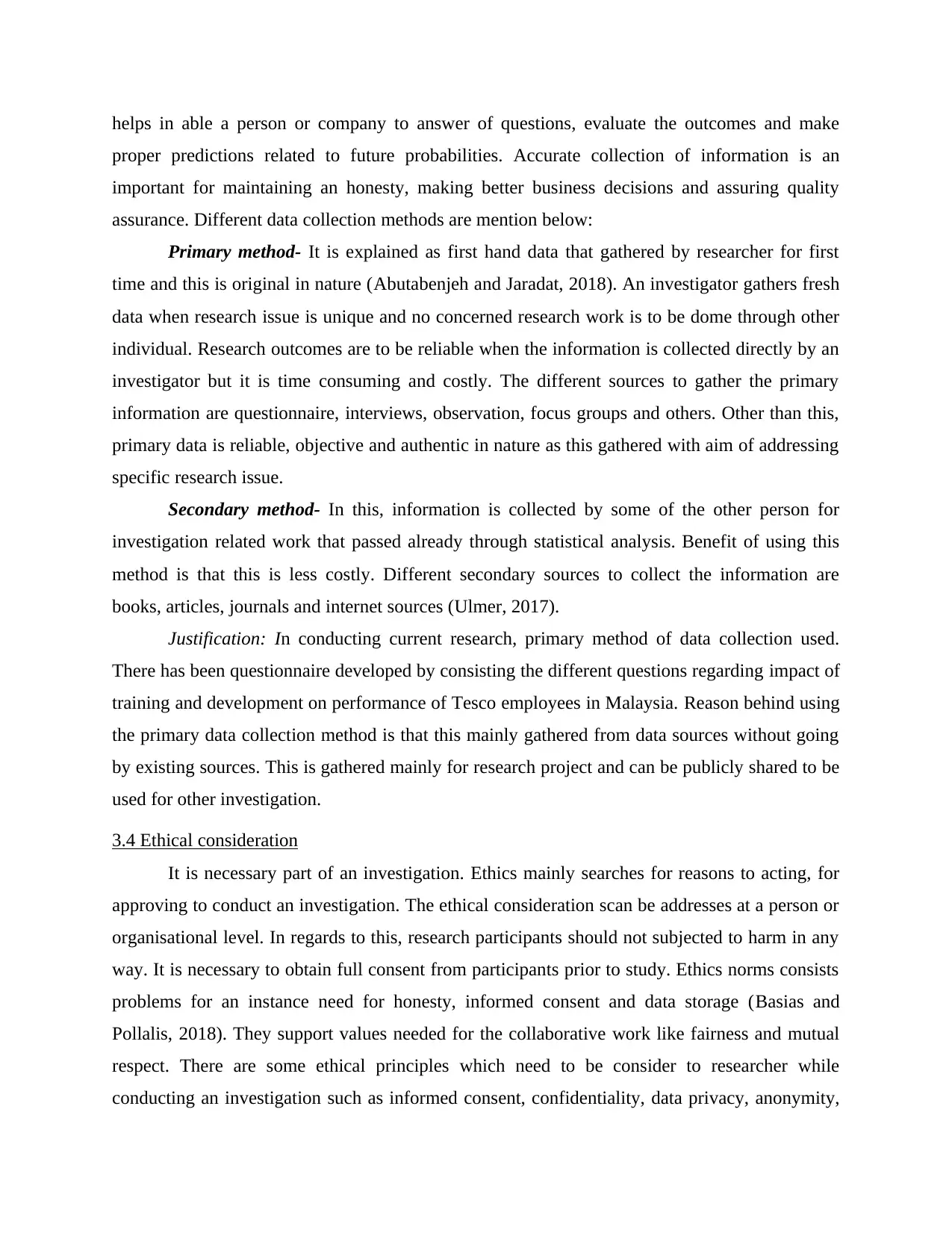
helps in able a person or company to answer of questions, evaluate the outcomes and make
proper predictions related to future probabilities. Accurate collection of information is an
important for maintaining an honesty, making better business decisions and assuring quality
assurance. Different data collection methods are mention below:
Primary method- It is explained as first hand data that gathered by researcher for first
time and this is original in nature (Abutabenjeh and Jaradat, 2018). An investigator gathers fresh
data when research issue is unique and no concerned research work is to be dome through other
individual. Research outcomes are to be reliable when the information is collected directly by an
investigator but it is time consuming and costly. The different sources to gather the primary
information are questionnaire, interviews, observation, focus groups and others. Other than this,
primary data is reliable, objective and authentic in nature as this gathered with aim of addressing
specific research issue.
Secondary method- In this, information is collected by some of the other person for
investigation related work that passed already through statistical analysis. Benefit of using this
method is that this is less costly. Different secondary sources to collect the information are
books, articles, journals and internet sources (Ulmer, 2017).
Justification: In conducting current research, primary method of data collection used.
There has been questionnaire developed by consisting the different questions regarding impact of
training and development on performance of Tesco employees in Malaysia. Reason behind using
the primary data collection method is that this mainly gathered from data sources without going
by existing sources. This is gathered mainly for research project and can be publicly shared to be
used for other investigation.
3.4 Ethical consideration
It is necessary part of an investigation. Ethics mainly searches for reasons to acting, for
approving to conduct an investigation. The ethical consideration scan be addresses at a person or
organisational level. In regards to this, research participants should not subjected to harm in any
way. It is necessary to obtain full consent from participants prior to study. Ethics norms consists
problems for an instance need for honesty, informed consent and data storage (Basias and
Pollalis, 2018). They support values needed for the collaborative work like fairness and mutual
respect. There are some ethical principles which need to be consider to researcher while
conducting an investigation such as informed consent, confidentiality, data privacy, anonymity,
proper predictions related to future probabilities. Accurate collection of information is an
important for maintaining an honesty, making better business decisions and assuring quality
assurance. Different data collection methods are mention below:
Primary method- It is explained as first hand data that gathered by researcher for first
time and this is original in nature (Abutabenjeh and Jaradat, 2018). An investigator gathers fresh
data when research issue is unique and no concerned research work is to be dome through other
individual. Research outcomes are to be reliable when the information is collected directly by an
investigator but it is time consuming and costly. The different sources to gather the primary
information are questionnaire, interviews, observation, focus groups and others. Other than this,
primary data is reliable, objective and authentic in nature as this gathered with aim of addressing
specific research issue.
Secondary method- In this, information is collected by some of the other person for
investigation related work that passed already through statistical analysis. Benefit of using this
method is that this is less costly. Different secondary sources to collect the information are
books, articles, journals and internet sources (Ulmer, 2017).
Justification: In conducting current research, primary method of data collection used.
There has been questionnaire developed by consisting the different questions regarding impact of
training and development on performance of Tesco employees in Malaysia. Reason behind using
the primary data collection method is that this mainly gathered from data sources without going
by existing sources. This is gathered mainly for research project and can be publicly shared to be
used for other investigation.
3.4 Ethical consideration
It is necessary part of an investigation. Ethics mainly searches for reasons to acting, for
approving to conduct an investigation. The ethical consideration scan be addresses at a person or
organisational level. In regards to this, research participants should not subjected to harm in any
way. It is necessary to obtain full consent from participants prior to study. Ethics norms consists
problems for an instance need for honesty, informed consent and data storage (Basias and
Pollalis, 2018). They support values needed for the collaborative work like fairness and mutual
respect. There are some ethical principles which need to be consider to researcher while
conducting an investigation such as informed consent, confidentiality, data privacy, anonymity,
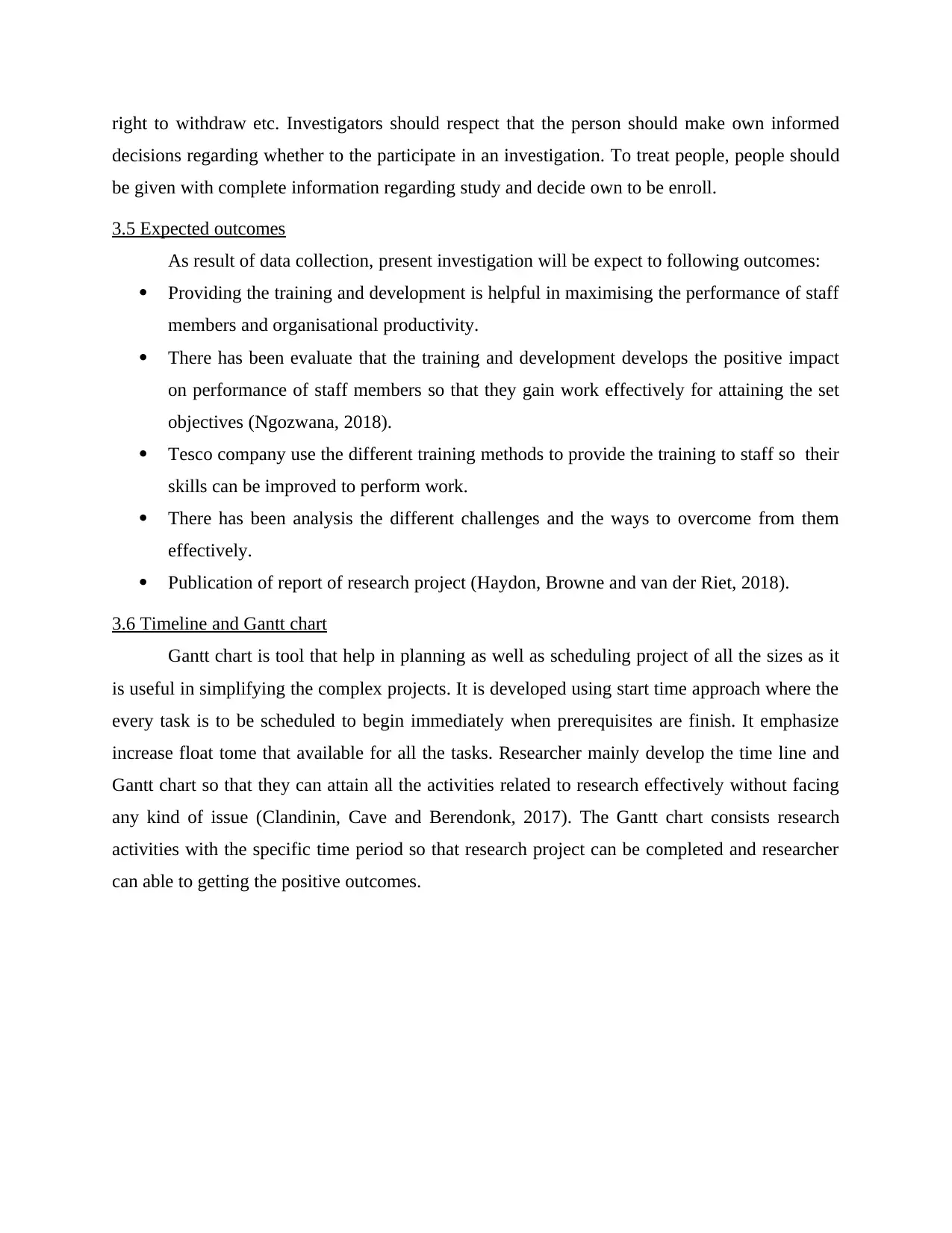
right to withdraw etc. Investigators should respect that the person should make own informed
decisions regarding whether to the participate in an investigation. To treat people, people should
be given with complete information regarding study and decide own to be enroll.
3.5 Expected outcomes
As result of data collection, present investigation will be expect to following outcomes:
Providing the training and development is helpful in maximising the performance of staff
members and organisational productivity.
There has been evaluate that the training and development develops the positive impact
on performance of staff members so that they gain work effectively for attaining the set
objectives (Ngozwana, 2018).
Tesco company use the different training methods to provide the training to staff so their
skills can be improved to perform work.
There has been analysis the different challenges and the ways to overcome from them
effectively.
Publication of report of research project (Haydon, Browne and van der Riet, 2018).
3.6 Timeline and Gantt chart
Gantt chart is tool that help in planning as well as scheduling project of all the sizes as it
is useful in simplifying the complex projects. It is developed using start time approach where the
every task is to be scheduled to begin immediately when prerequisites are finish. It emphasize
increase float tome that available for all the tasks. Researcher mainly develop the time line and
Gantt chart so that they can attain all the activities related to research effectively without facing
any kind of issue (Clandinin, Cave and Berendonk, 2017). The Gantt chart consists research
activities with the specific time period so that research project can be completed and researcher
can able to getting the positive outcomes.
decisions regarding whether to the participate in an investigation. To treat people, people should
be given with complete information regarding study and decide own to be enroll.
3.5 Expected outcomes
As result of data collection, present investigation will be expect to following outcomes:
Providing the training and development is helpful in maximising the performance of staff
members and organisational productivity.
There has been evaluate that the training and development develops the positive impact
on performance of staff members so that they gain work effectively for attaining the set
objectives (Ngozwana, 2018).
Tesco company use the different training methods to provide the training to staff so their
skills can be improved to perform work.
There has been analysis the different challenges and the ways to overcome from them
effectively.
Publication of report of research project (Haydon, Browne and van der Riet, 2018).
3.6 Timeline and Gantt chart
Gantt chart is tool that help in planning as well as scheduling project of all the sizes as it
is useful in simplifying the complex projects. It is developed using start time approach where the
every task is to be scheduled to begin immediately when prerequisites are finish. It emphasize
increase float tome that available for all the tasks. Researcher mainly develop the time line and
Gantt chart so that they can attain all the activities related to research effectively without facing
any kind of issue (Clandinin, Cave and Berendonk, 2017). The Gantt chart consists research
activities with the specific time period so that research project can be completed and researcher
can able to getting the positive outcomes.
⊘ This is a preview!⊘
Do you want full access?
Subscribe today to unlock all pages.

Trusted by 1+ million students worldwide
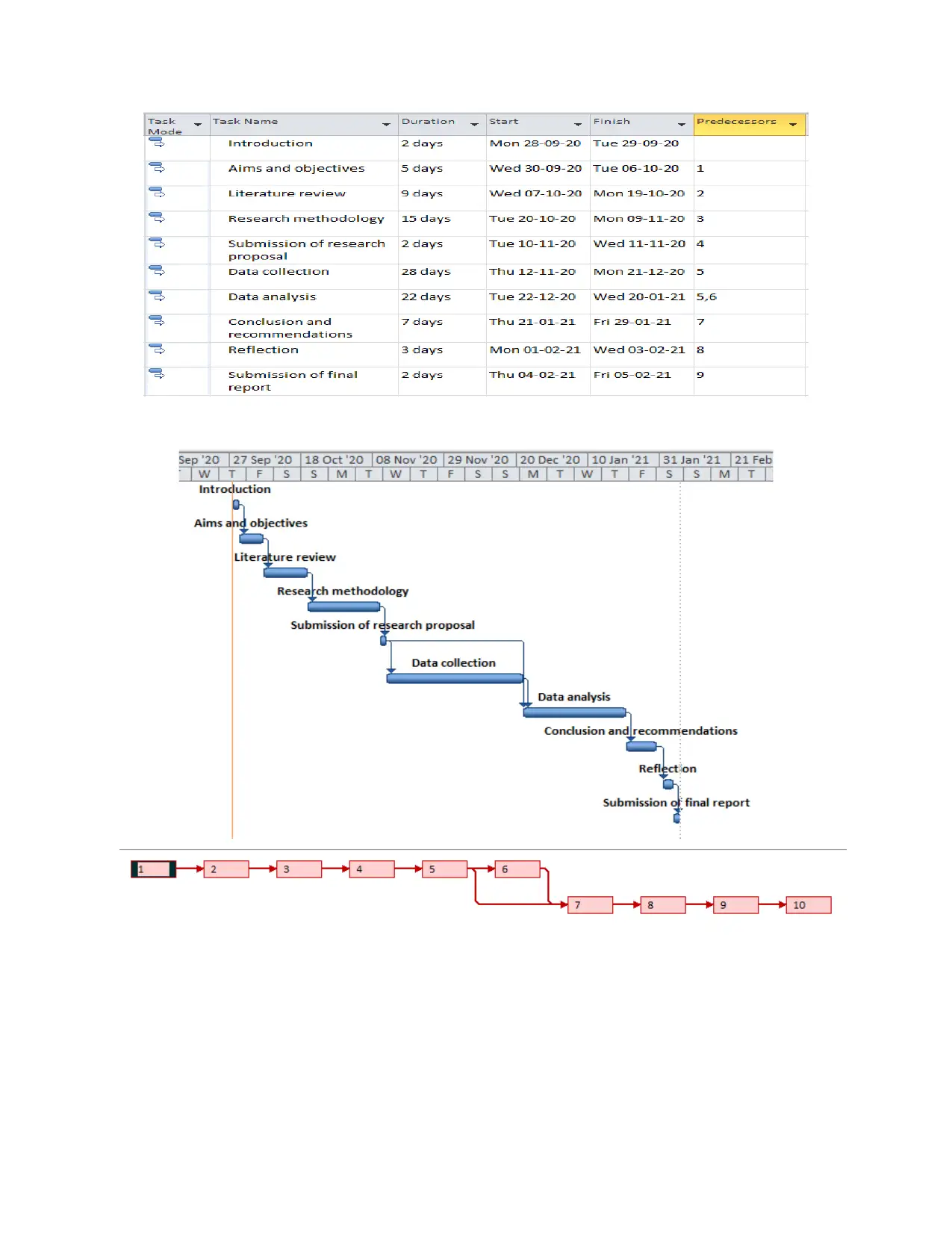
Paraphrase This Document
Need a fresh take? Get an instant paraphrase of this document with our AI Paraphraser
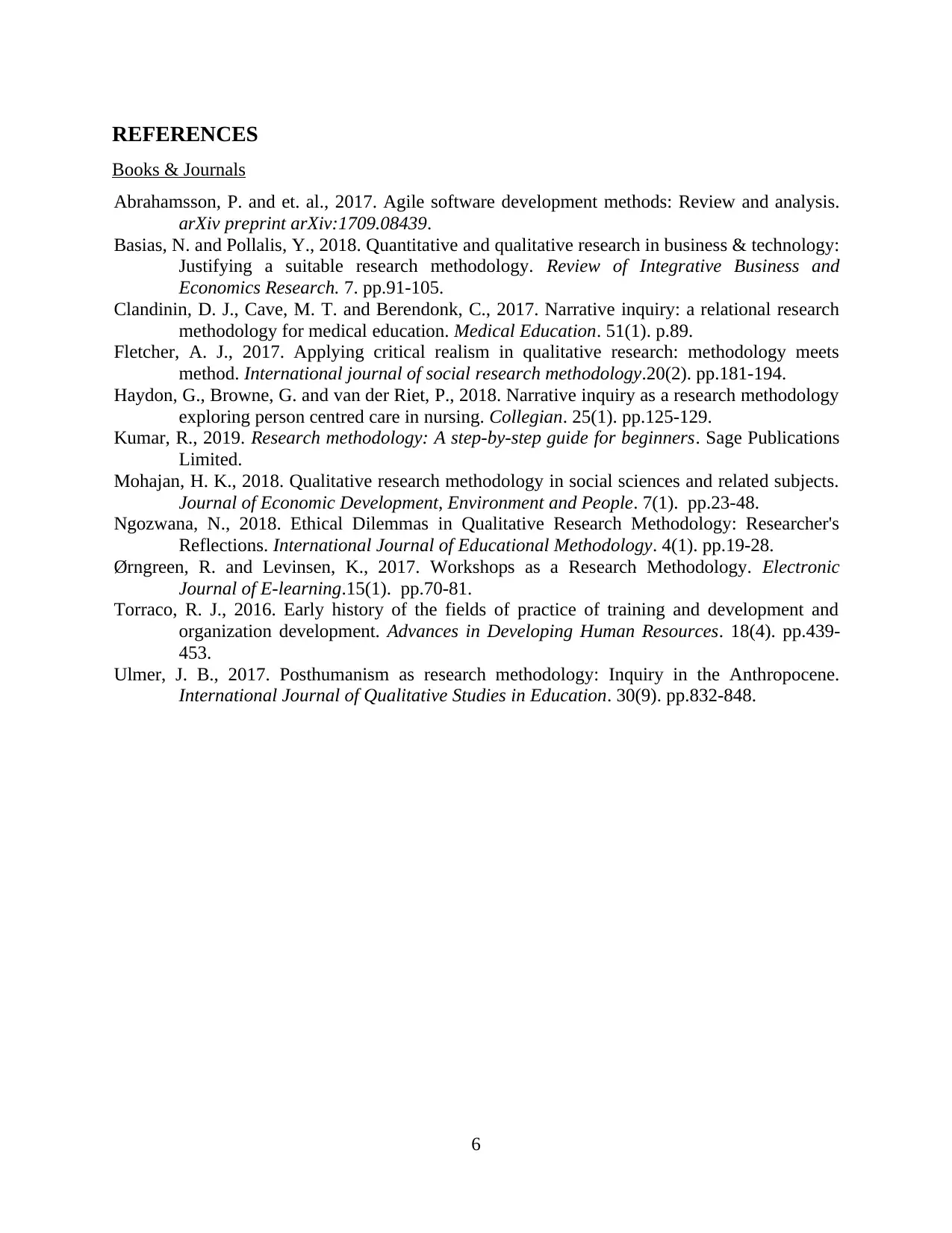
REFERENCES
Books & Journals
Abrahamsson, P. and et. al., 2017. Agile software development methods: Review and analysis.
arXiv preprint arXiv:1709.08439.
Basias, N. and Pollalis, Y., 2018. Quantitative and qualitative research in business & technology:
Justifying a suitable research methodology. Review of Integrative Business and
Economics Research. 7. pp.91-105.
Clandinin, D. J., Cave, M. T. and Berendonk, C., 2017. Narrative inquiry: a relational research
methodology for medical education. Medical Education. 51(1). p.89.
Fletcher, A. J., 2017. Applying critical realism in qualitative research: methodology meets
method. International journal of social research methodology.20(2). pp.181-194.
Haydon, G., Browne, G. and van der Riet, P., 2018. Narrative inquiry as a research methodology
exploring person centred care in nursing. Collegian. 25(1). pp.125-129.
Kumar, R., 2019. Research methodology: A step-by-step guide for beginners. Sage Publications
Limited.
Mohajan, H. K., 2018. Qualitative research methodology in social sciences and related subjects.
Journal of Economic Development, Environment and People. 7(1). pp.23-48.
Ngozwana, N., 2018. Ethical Dilemmas in Qualitative Research Methodology: Researcher's
Reflections. International Journal of Educational Methodology. 4(1). pp.19-28.
Ørngreen, R. and Levinsen, K., 2017. Workshops as a Research Methodology. Electronic
Journal of E-learning.15(1). pp.70-81.
Torraco, R. J., 2016. Early history of the fields of practice of training and development and
organization development. Advances in Developing Human Resources. 18(4). pp.439-
453.
Ulmer, J. B., 2017. Posthumanism as research methodology: Inquiry in the Anthropocene.
International Journal of Qualitative Studies in Education. 30(9). pp.832-848.
6
Books & Journals
Abrahamsson, P. and et. al., 2017. Agile software development methods: Review and analysis.
arXiv preprint arXiv:1709.08439.
Basias, N. and Pollalis, Y., 2018. Quantitative and qualitative research in business & technology:
Justifying a suitable research methodology. Review of Integrative Business and
Economics Research. 7. pp.91-105.
Clandinin, D. J., Cave, M. T. and Berendonk, C., 2017. Narrative inquiry: a relational research
methodology for medical education. Medical Education. 51(1). p.89.
Fletcher, A. J., 2017. Applying critical realism in qualitative research: methodology meets
method. International journal of social research methodology.20(2). pp.181-194.
Haydon, G., Browne, G. and van der Riet, P., 2018. Narrative inquiry as a research methodology
exploring person centred care in nursing. Collegian. 25(1). pp.125-129.
Kumar, R., 2019. Research methodology: A step-by-step guide for beginners. Sage Publications
Limited.
Mohajan, H. K., 2018. Qualitative research methodology in social sciences and related subjects.
Journal of Economic Development, Environment and People. 7(1). pp.23-48.
Ngozwana, N., 2018. Ethical Dilemmas in Qualitative Research Methodology: Researcher's
Reflections. International Journal of Educational Methodology. 4(1). pp.19-28.
Ørngreen, R. and Levinsen, K., 2017. Workshops as a Research Methodology. Electronic
Journal of E-learning.15(1). pp.70-81.
Torraco, R. J., 2016. Early history of the fields of practice of training and development and
organization development. Advances in Developing Human Resources. 18(4). pp.439-
453.
Ulmer, J. B., 2017. Posthumanism as research methodology: Inquiry in the Anthropocene.
International Journal of Qualitative Studies in Education. 30(9). pp.832-848.
6

APPENDIX
QUESTIONNAIRE
Name:
Age:
Gender:
Q1) How long you are working in Tesco company?
a) 1 – 2 years
b) 3 - 4 years
c) 5 – 8 years
d) More than 8 years
Q2) Indicate that how many training and development programs organised as part of
Tesco within year?
a) 2 to 3
b) 4 to 5
c) More than 5
Q3) As per your perspective, does training and develops helps in improving employee
performance?
a) Yes
b) No
Q4) In which manner, training and development programs impact on the performance
level of staff members in Tesco?
a) Positive manner
b) Negative manner
Q5) What is the importance of training and development to an organisation?
a) Addressing weaknesses
b) Enhance company goodwill
c) Employee satisfaction
d) Enhanced productivity
Q6) What are the reasons to provide the training to staff members?
a) Increased job satisfaction
7
QUESTIONNAIRE
Name:
Age:
Gender:
Q1) How long you are working in Tesco company?
a) 1 – 2 years
b) 3 - 4 years
c) 5 – 8 years
d) More than 8 years
Q2) Indicate that how many training and development programs organised as part of
Tesco within year?
a) 2 to 3
b) 4 to 5
c) More than 5
Q3) As per your perspective, does training and develops helps in improving employee
performance?
a) Yes
b) No
Q4) In which manner, training and development programs impact on the performance
level of staff members in Tesco?
a) Positive manner
b) Negative manner
Q5) What is the importance of training and development to an organisation?
a) Addressing weaknesses
b) Enhance company goodwill
c) Employee satisfaction
d) Enhanced productivity
Q6) What are the reasons to provide the training to staff members?
a) Increased job satisfaction
7
⊘ This is a preview!⊘
Do you want full access?
Subscribe today to unlock all pages.

Trusted by 1+ million students worldwide
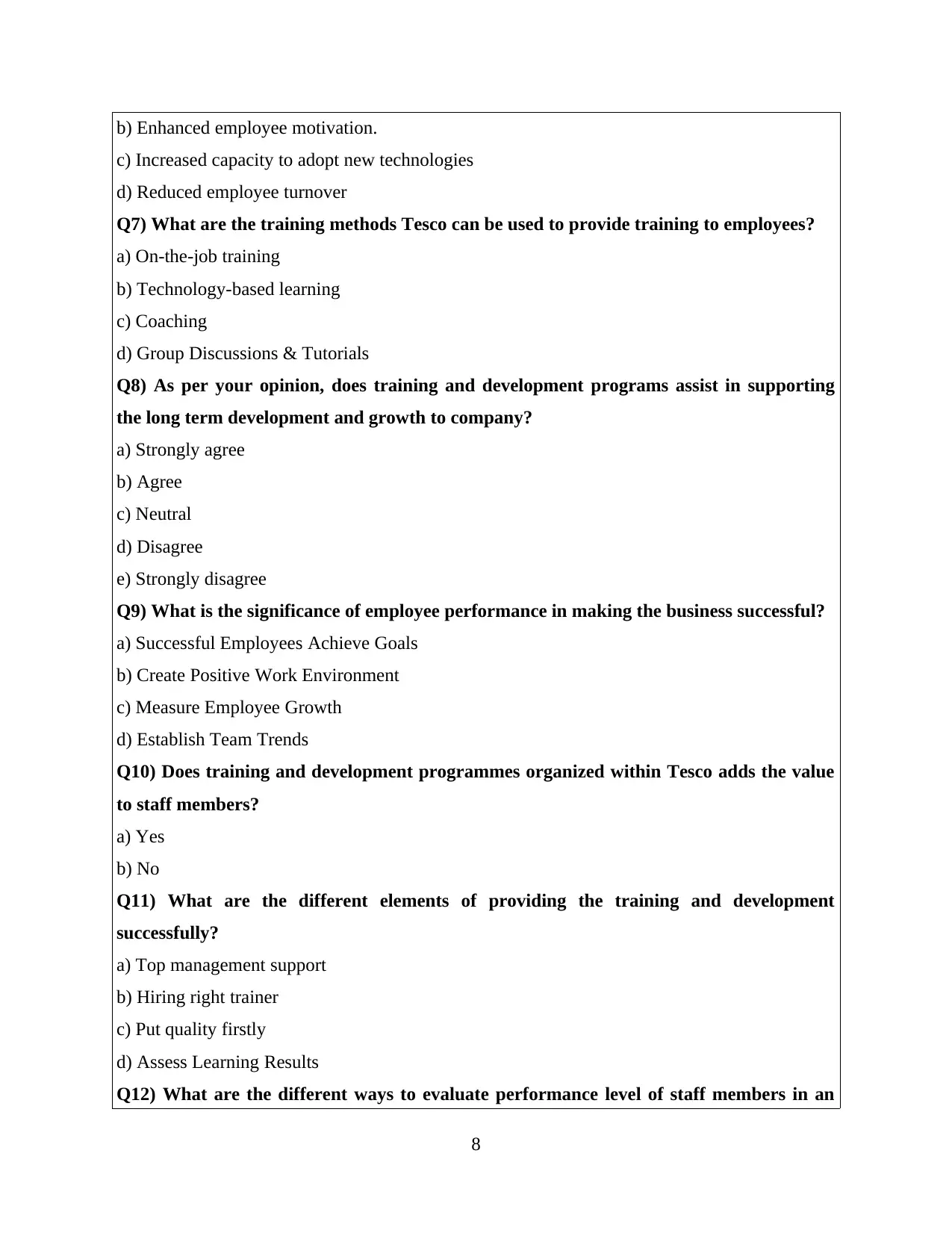
b) Enhanced employee motivation.
c) Increased capacity to adopt new technologies
d) Reduced employee turnover
Q7) What are the training methods Tesco can be used to provide training to employees?
a) On-the-job training
b) Technology-based learning
c) Coaching
d) Group Discussions & Tutorials
Q8) As per your opinion, does training and development programs assist in supporting
the long term development and growth to company?
a) Strongly agree
b) Agree
c) Neutral
d) Disagree
e) Strongly disagree
Q9) What is the significance of employee performance in making the business successful?
a) Successful Employees Achieve Goals
b) Create Positive Work Environment
c) Measure Employee Growth
d) Establish Team Trends
Q10) Does training and development programmes organized within Tesco adds the value
to staff members?
a) Yes
b) No
Q11) What are the different elements of providing the training and development
successfully?
a) Top management support
b) Hiring right trainer
c) Put quality firstly
d) Assess Learning Results
Q12) What are the different ways to evaluate performance level of staff members in an
8
c) Increased capacity to adopt new technologies
d) Reduced employee turnover
Q7) What are the training methods Tesco can be used to provide training to employees?
a) On-the-job training
b) Technology-based learning
c) Coaching
d) Group Discussions & Tutorials
Q8) As per your opinion, does training and development programs assist in supporting
the long term development and growth to company?
a) Strongly agree
b) Agree
c) Neutral
d) Disagree
e) Strongly disagree
Q9) What is the significance of employee performance in making the business successful?
a) Successful Employees Achieve Goals
b) Create Positive Work Environment
c) Measure Employee Growth
d) Establish Team Trends
Q10) Does training and development programmes organized within Tesco adds the value
to staff members?
a) Yes
b) No
Q11) What are the different elements of providing the training and development
successfully?
a) Top management support
b) Hiring right trainer
c) Put quality firstly
d) Assess Learning Results
Q12) What are the different ways to evaluate performance level of staff members in an
8
Paraphrase This Document
Need a fresh take? Get an instant paraphrase of this document with our AI Paraphraser

organisation?
a) Management by objectives
b) 360-degree feedback
c) Scale and ranking methods
d) Employee self-evaluation
Q13) How management can encourage the staff members to attend training at workplace?
a) Give Employees Reason to Attend
b) Create Excitement
c) Make the Session Valuable
d) Be Respectful and Flexible
Q13) What are the challenges faced by company related to training and development?
a) Unsafe Work Environments
b) A dispersed workforce
c) Different learning habits
d) Lack of engagement
Q14) What is the impact of lack of employee training and development to organisation?
a) Unsatisfied Employees
b) Reduced Productivity
c) Increased Staff Turnover
Q15) Which effective ways company can be adopt to overcome from the training and
development related issues?
a) Using microlearning approach
b) Use social tools
c) Conduct thorough needs analysis
d) Incorporate practical learning activities
Q16) Which different challenges are faced through company related to employee
performance?
a) Complex performance management
b) Inadequate tools
c) Limited mobile and cloud solutions
d) Unfocused appraisals
9
a) Management by objectives
b) 360-degree feedback
c) Scale and ranking methods
d) Employee self-evaluation
Q13) How management can encourage the staff members to attend training at workplace?
a) Give Employees Reason to Attend
b) Create Excitement
c) Make the Session Valuable
d) Be Respectful and Flexible
Q13) What are the challenges faced by company related to training and development?
a) Unsafe Work Environments
b) A dispersed workforce
c) Different learning habits
d) Lack of engagement
Q14) What is the impact of lack of employee training and development to organisation?
a) Unsatisfied Employees
b) Reduced Productivity
c) Increased Staff Turnover
Q15) Which effective ways company can be adopt to overcome from the training and
development related issues?
a) Using microlearning approach
b) Use social tools
c) Conduct thorough needs analysis
d) Incorporate practical learning activities
Q16) Which different challenges are faced through company related to employee
performance?
a) Complex performance management
b) Inadequate tools
c) Limited mobile and cloud solutions
d) Unfocused appraisals
9
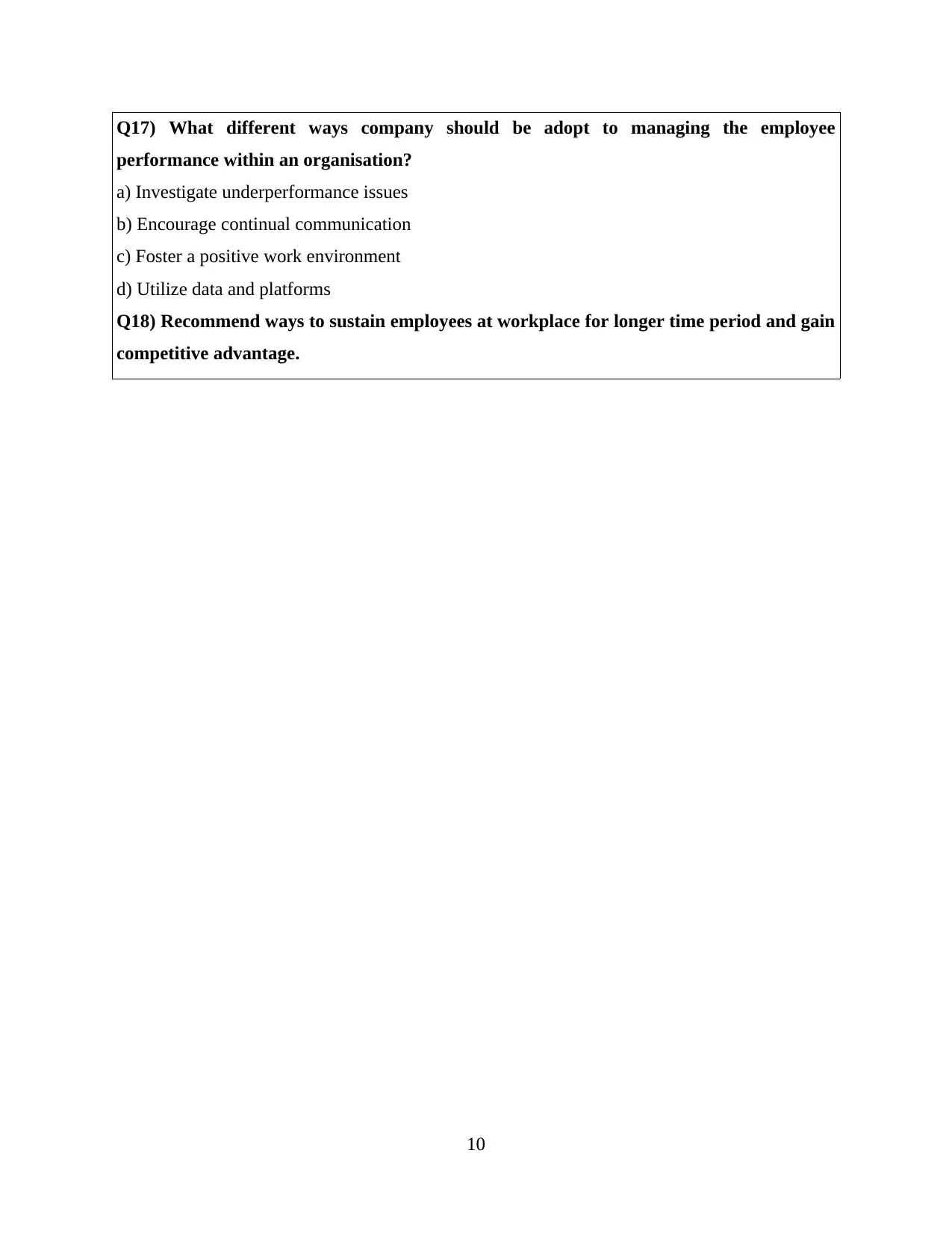
Q17) What different ways company should be adopt to managing the employee
performance within an organisation?
a) Investigate underperformance issues
b) Encourage continual communication
c) Foster a positive work environment
d) Utilize data and platforms
Q18) Recommend ways to sustain employees at workplace for longer time period and gain
competitive advantage.
10
performance within an organisation?
a) Investigate underperformance issues
b) Encourage continual communication
c) Foster a positive work environment
d) Utilize data and platforms
Q18) Recommend ways to sustain employees at workplace for longer time period and gain
competitive advantage.
10
⊘ This is a preview!⊘
Do you want full access?
Subscribe today to unlock all pages.

Trusted by 1+ million students worldwide
1 out of 12
Related Documents
Your All-in-One AI-Powered Toolkit for Academic Success.
+13062052269
info@desklib.com
Available 24*7 on WhatsApp / Email
![[object Object]](/_next/static/media/star-bottom.7253800d.svg)
Unlock your academic potential
Copyright © 2020–2025 A2Z Services. All Rights Reserved. Developed and managed by ZUCOL.





